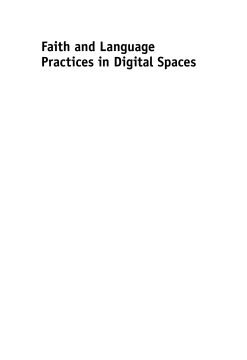
Additional Information
Book Details
Abstract
This volume shares the results of research conducted within and across the complex nexus of language, religion and new technologies. It identifies the dynamic and mobile ways religious practice and language interact online to modify, confirm, transform and consolidate linguistic resources and repertoires. It makes a significant contribution to work in the emerging sub-discipline of the sociology of language and religion and adds to the growing work on digital religion. It also showcases leading and ground-breaking researchers working on online and offline examples of the complex relationships evinced by the study of language and religion. The chapter authors explore a wide range of religions, technologies and languages in order to provide an innovative insight into the overlap between the study of language and religion and language and technology.
From Muslim televangelist discourses and Brazilian Pentacostalist language ideologies on Facebook to the impact of Nigerian internet platforms on religious worship. From Christian digital parishes to online Hindu practices and Yiddish Wikipedia groups, this volume captures in fascinating detail the technological and discursive strategies of religious groups in our modern age as they reinvent their communities in cyberspace.
Research in the Sociology of Language and Religion (SLR) has been gaining momentum over the past decade or so. This volume advances the discussion by focusing on computer and telephonic technologies. Students of religion and sociolinguistics alike will benefit from these skillful probes of the digital world in which we now seem to live and move and have our being.
Andrey Rosowsky is a Senior Lecturer in Education at the University of Sheffield, UK. He is the author of Heavenly Readings: Liturgical Literacy in a Multilingual Context (Multilingual Matters, 2008).
This volume does a good job of navigating the various theoretical backgrounds involved in the discussion of language and faith online, by offering a variety of analyses of how these factors interact in different contexts and in different communities. It successfully opens the discussion of the intersection of faith and language online, which have been analyzed separately as they are performed in digital spaces. However, faith and language are often intertwined and inseparable as components of social practice. This volume provides a way forward as to how analysis can be conducted to ascertain the ways in which these factors interact with each other in digital spaces.
Jordan Jordan Lavender, Colby College, USA
The explosion of online resources will inevitably affect religion, the master emotion, as well as its handmaiden, that is, its language. In this modest but significant volume, technology, language and religion come together as a viable and potent nexus.
Table of Contents
| Section Title | Page | Action | Price |
|---|---|---|---|
| DOI 10.21832/ROSOWS9276 | iv | ||
| Contents | v | ||
| Acknowledgements | vii | ||
| Figures | viii | ||
| Tables | x | ||
| Contributors | xi | ||
| 1 Faith and Language Practices in Digital Spaces: An Introduction | 1 | ||
| Part 1 Faith, Language and Social Media | 17 | ||
| 2 Re-Parishing in Social Media: Identity-Based VirtualFaith Communities and Physical Parishes | 19 | ||
| 3 Facebook: A Medium for the Language Planning of Migrant Churches | 45 | ||
| Part 2 Faith, Language and Transnational Online Practices | 69 | ||
| 4 Ifa, the Word and the Virtual World: A Study of the Perceptions of and Attitudes toward Ifa Religious Tradition on the Internet | 71 | ||
| 5 Globalising Yoruba Taboos and their Sociocultural andReligious Values | 91 | ||
| 6 Yiddish Wikipedia: History Revisited | 113 | ||
| Part 3 Faith, Language and Online Televangelism | 133 | ||
| 7 Digital Evangelism: Varieties of English in Unexpected Places | 135 | ||
| 8 American Muslim Televangelists as Religious Celebrities: The Changing ‘Face’ of Religious Discourse | 158 | ||
| Part 4 Faith, Language and Online Ritual | 183 | ||
| 9 Online Satsang and Online Puja: Faith and Language in the Era of Globalisation | 185 | ||
| 10 Virtual Allegiance: Online ‘Bayʿah’ Practices within a Worldwide Sufi Order | 209 | ||
| Part 5 Afterword | 235 | ||
| 11 Afterword | 237 | ||
| Index | 242 |
